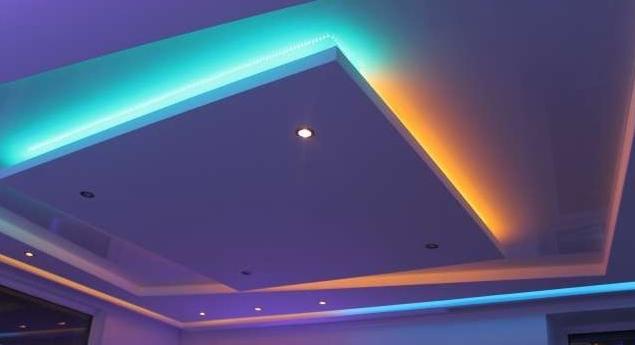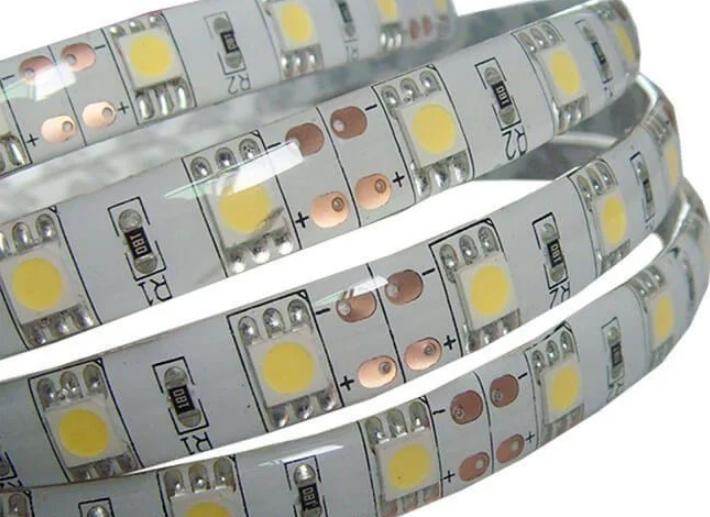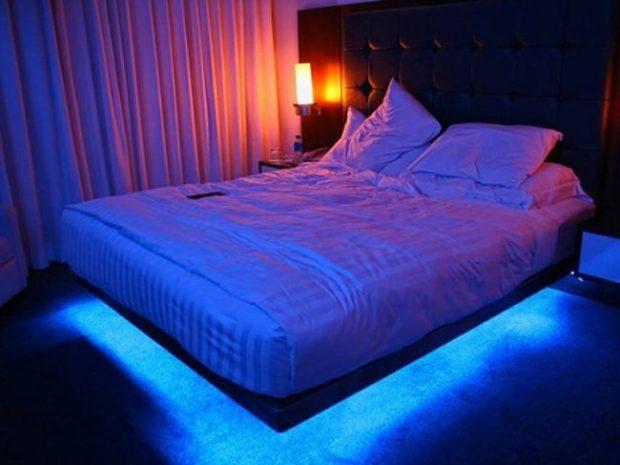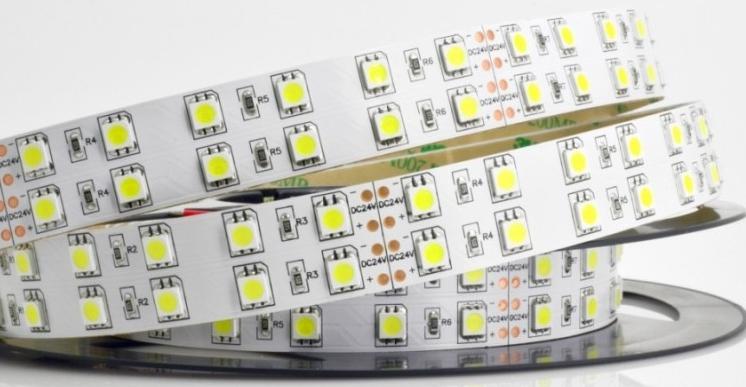How to install LED strip on the ceiling
LED ceiling illumination is used in rooms more and more often, as it provides not only a decorative effect, but can also serve as basic lighting. The main advantage is that anyone can put a strip, if he will follow the instructions and pick up high-quality elements for the system.

Pros and cons of the solution
First of all, you need to understand the advantages and disadvantages of this option to understand whether it is suitable. In most cases, there is simply no alternative, as the LED strip is much cheaper than analogues with similar properties and it can be bought in almost every electrical store. The main advantages are as follows:
- Safety of the system. Most often the operating voltage is 12 V, less often 24 V. Both are not life-threatening and in case of electrocution, human health will not suffer.
- Versatility. The tape can be installed in living rooms, bathrooms, toilets, kitchens and even outdoors. For places with high humidity it is worth choosing waterproof products, they are much more expensive.
- Compactness. Tape occupies little space - a maximum of a couple of centimeters in width and literally 5-10 mm in height. This allows its placement in any niches, cavities or on the ceiling.
- Flexibility. The base is well bendable, so when fastening on corners, uneven or oval surfaces no problems will not arise. You just need to remove the protective layer and glue the tape to the base.
- Ability to adjust the length. Places for cutting are usually arranged in 5 cm, but there are types that can be cut in 1-3 cm. Choosing the exact length is not difficult, you can cut as much as you need. But variants with 24 V voltage are cut in 5-10 cm, it is worth remembering.
- Simple installation. Following the instructions and having at hand a simple set of tools you can put the strip with your own hands.
- Low power consumption, it is one of the most economical options, so the cost of lighting will be reduced.
- Long service life. Normal good quality tape works for at least 10 years, which is much longer than any analogue.
- During operation, LEDs are heated weakly, you do not need to make a system for heat removal.
- You can control it with a switch, remote control or an app from a smartphone.
- Large selection, there are both monochrome and multicolored options.

Information! No harmful substances are emitted when burning. Even if you damage the tape, nothing terrible will happen, there are no mercury vapors or glass elements in it.
LED strip has disadvantages, but they are much less than the advantages:
- For multicolor versions, you have to use a controller, which costs a lot and fails faster than the strip itself.
- With a length of 3 meters or more, the end does not shine as brightly as the beginning because of current loss. The problem can be solved by feeding the wire to both sides, but this complicates and increases the cost of the project.
- The maximum length of one piece at 12 V is 5 m, at 24 V it is 10 m. But it is possible to connect several sections in parallel.
Ribbon ceiling lighting is not difficult to do, but the room will be transformed. And thanks to the controller you can change the brightness and shades.
Choice of LED strip for different rooms
When buying strips you need to understand where it will be used and for what purpose. Only then can you choose a specific option. It is not necessary to use the same product everywhere, take into account the peculiarities of the room and the nature of the work of illumination.

Before you buy, you should measure the approximate length of the tape to find the right size roll. But the first thing to consider is the installation location. Use the recommendations in the next section.
What criteria to pay attention to, what is better
Considering the specifics for each room, you can decide what's best for you:
- In the bathroom, use only moisture-proof models. You can illuminate niches, the place in front of the mirror or the perimeter, or you can make the strip the main lighting.
- In the bathroom, because of the small area, you can fix a monochrome version on the perimeter and provide good light.
- In the kitchen, the scope of application is very wide. You can illuminate the work area, shelves in cabinets. Often niches are made or perimeter lighting is laid.General lighting in the kitchen.
- In the children's room, LEDs can serve as a nightlight with minimal brightness. It is also possible to illuminate the play area.
- For corridors, it is better to choose monochromatic options, pay attention to the brightness indicators, so that the light was of high quality.
- In the bedroom, you can make both decorative and basic lighting. The choice of type and characteristics depends on this. The light should be subdued.
- In the living room, it is better to use powerful single-color ribbons for general lighting or RGB options for decorative lighting. You can illuminate individual zones or niches.
Important! Use lighting standards when choosing LED strips in different rooms.
The best LED strips for ceiling illumination
There are many options on sale, so it can be difficult to choose. Preliminarily it is necessary to understand the brightness, in order to understand what power is required. It depends on the number of LEDs per meter and their size. As for varieties, it is best to use these options:
- Monochrome, best for general lighting or white niche and cornice lighting. Burns brightly, light quality is good.
- RGB ribbon is a combination of three colors of LEDs: red, green and blue. By changing their brightness and intensity can achieve different shades and even make white light. But in quality it will be an order of magnitude worse than the monochrome version.
- RGBW consists not only of colored diodes, there is a white, which burns bright cool light (about 6000 K). Can be used for both backlighting and lighting, but because of the high brightness it will not suit everyone.
- RGBWW - A solution that adds another white LED with a warm light (2400-2700 K). It can be used as a backlight and as a main light, because the brightness can be adjusted as desired.

If you want to combine the main light and decorative lighting, you can lay two strips side by side. But this option will cost more than combined ribbons with high-quality white light.
Which installation option to choose, the main varieties
LED strip on the ceiling can be attached in different ways. Therefore, it is necessary to decide in advance how best to put it. It is necessary to prepare the base in advance, and sometimes make special constructions even at the stage of repairing the ceiling. There are several basic ways:
- Placement of lighting in niches along the perimeter of the ceiling or along the cornice. In this case, when installing the plasterboard structure, a gap is left in which the LED strip is placed.
- Protrusions in the ceiling multilevel designs. In this case, the construction of frameworks or tensioning the cloth left a small shelf in which the strip is placed LEDs up and illuminate the surface.The version with a projection on the perimeter looks spectacular.
- Using an aluminum profile, specially adapted for the LED strip. The advantage of this option is that it is easy to mount, the appearance of the design is neat, and the LEDs are closed with a diffuser, so the light is uniform.
- Wrapping around the perimeter of the ceiling. The easiest way, which at the same time looks good.
After choosing the method it will become clear what to buy and how to properly organize the work.
Description of the installation of LED lighting with their own hands
To do the work correctly, it is necessary to follow the step-by-step instructions. In this case, it is not difficult, but it requires accuracy and precision. The tape for all its advantages is easy to damage, especially if it is attached carelessly.
Preparation, necessary materials
First of all, it is necessary to buy the LED strip of the selected type. Always make a reserve of 10-15%, so that it did not turn out so that there is not enough 5-10 cm. Also prepare everything you need:
- Controller for multicolor versions. Select according to the total power of LEDs and type of strip. If the length is long, it is worth using several controllers to distribute the load.
- Dimmer to regulate brightness and shades. Put as desired.
- Copper wires for connection. Heat shrink tubing to insulate the connections.
- Aluminum profile, if it will be used to run the lights.
- A small soldering iron to connect the contacts. Sometimes only connectors are needed.
- A construction knife, scissors of medium or large size.

It is important to prepare a place for installation, here everything depends on the specifics of installation. If the tape will be glued, the surfaces must be leveled and cleaned of dust and dirt. You can degrease the base, wiping it with a rag soaked in solvent. This will ensure good adhesion of the double-sided tape.
Note! If the surface is porous, it is advisable to prime it to strengthen the structure.
Wiring diagram
Before working, it is necessary to draw at least the simplest diagram, on which to mark all the important points:
- The place of connection of the cable supplying electricity.
- The location of the unit or units of power and controllers. They should be easily accessible so that they can be checked or replaced if necessary.
- The length of the ribbons, this determines the power of the equipment and the number of controllers, as well as the way they are connected.
- If you need to put two power supplies, connect them in parallel. When one unit is put two strips, then connect them as shown in the diagram below.

Mounting and connection to the power
If the preparation is done correctly, it is not difficult to install the LED strip. The process consists of several steps:
- Take measurements and cut a piece of the right length, if required. Cut only along the dotted lines that have contacts on them. Connect the wires with a connector or by soldering them.
- If you want to connect two tapes, you can solder them directly on the contacts, the thickness of the base allows you to do this. Or use small pieces of wire.
- Connect the power supply and the controller, following the diagram. The main thing is not to mix up the pins, so as not to disable the equipment. Check the operation beforehand.
- Fasten the ribbon.To do this, it must be carefully glued along the line, gradually removing the protective layer on the back side. Place in the cavities or glue with double-sided adhesive tape the power supply and the controller.

Important! The main thing is not to mix up the wires, as then you will have to redo the work. The tape will not burn out because of this.
Video on the subject:
Common mistakes when installing
There are a few mistakes that are often made when installing and that make the LED strip last much less. Remember a few tips:
- Do not fix the lights with plastic clamps. They squeeze the base and it burns out in these places.
- Do not connect ribbons in series if the total length is more than 5 m.
- If you use a version with silicone coating, it is better to glue it to the aluminum profile, which serves as a cooling radiator and eliminates overheating.
- Choose a power supply with at least 30% power reserve. If it is constantly running at the limit, it will not last long.

If you understand the subject, it is not difficult to choose a LED strip and install it on the ceiling. The main thing - to choose the right power supply and controller, not to mix up the wires when connecting and securely fasten the backlight to the surface.



